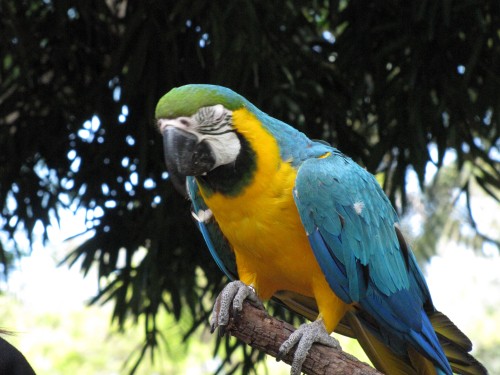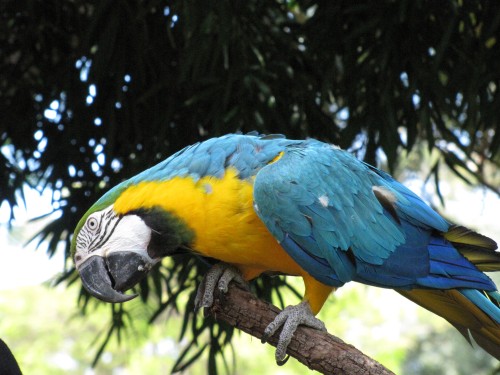Colombian hummingbird rediscovered
Blue-bearded Helmetcrest (Oxypogon cyanolaemus)
I don’t feature non-Australian birds very often on this site and I should correct this oversight. I have in the past shown birds photographed in Nepal, Thailand, Ethiopia, Morocco and Spain. (You can search for these using the search facility above.)
For two reasons I would love to go birding in Colombia, South America. First, it boasts the world’s largest list of bird species as well as the largest list of endemic species – that is, birds only found there and nowhere else. Second, I would love to visit the city of Cali, the birthplace of my two grandchildren.
News has come in recently of the rediscovery of a species of hummingbird, the Blue-bearded Helmetcrest (Oxypogon cyanolaemus) which had been thought to be extinct. The last sighting was as long ago as 1946. It must have been an exciting moment for the birders who made the discovery. To then manage to get the first ever photograph of the species must made the discovery even sweeter.
On the downside, the area in the Santa Marta mountains in Colombia where the birds were seen is under severe threat from clearing and burning by local farmers. I hope that provisions can be made to preserve both the birds and the environment on which they rely for their existence.
I can’t show the photo of the bird here for copyright reasons, so go to the link below. This will also take you to an interesting article about the bird’s rediscovery.
Further reading:
Gold and Blue Macaw, Adelaide Zoo
There are few more striking birds than the magnificent Gold and Blue Macaw.
Today’s photos again feature a non-Australian species and yet another that I’d love to see in its natural habitat, South America. At this stage there is little hope of seeing this species in the wild – unless my grandchildren – who were born Colombia – insist on me taking them to visit their birth country! (I can dream, can’t I?)
This individual is a part of the great bird collection at my home zoo in Adelaide, South Australia. It is featured in a small bird show at the zoo every day. The keeper allows the bird to fly freely around inside the perimeter of the zoo, all the while giving a talk about the species and other parrots. It’s a great educational experience to have a large, spectacular parrot flying just centimetres above the audience seated on the lawn in front of a low stage.
And somewhere I have a print of me holding this bird; it was taken at the zoo some years ago. (I don’t think that they allow the public to hold the bird these days.)
Review: A field guide to the birds of Colombia

Colombia in South America is every birder’s dream destination. With well over 1800 species – more than any other country – its vast range of wonderful species is an attraction many find irresistible. With the relative stabilisation politically in the last few years, many birders are making this a “must visit” country. I wish I could join them. Maybe one day.
I bought a copy as a gift for a family member with close ties to Colombia. Before giving the guide as a present I must admit I spent quite a few hours browsing – and dreaming. Would I one day be able to afford to travel there and see some of the colourful birds covered by this guide?
Colombia has been without a modern field guide for some decades. This volume fills the void admirably, covering every species ever recorded there. The authors note, however, that the forthcoming Spanish edition may well have a few additions to this, the English version. Species are being added every year as new knowledge of the nation’s natural environment emerges.
The authors have done an amazing job covering every bird species in a country so rich in bird life. This guide, despite covering every species, is lightweight, compact, thin and would travel easily in a backpack – or a large pocket. It is arranged in an easy to use manner with every species illustrated, many with both male and female plumage as well as some juvenile plumages. Where helpful to identification, species are shown in flight. That’s no mean feat with over 1800 species in only 225 smallish pages!
They have achieved this compactness by keeping the illustrations small; most are 3 – 4 cm and are to scale compared with others on the same page. Most pages cover 6 – 8 species on average. In addition to the illustrations, the information is very succinct and basic:
- Common English name,
- Taxonomic name,
- Size from head to tail (centimetres and inches)
- A short one or two sentence description of its preferred habitat and diagnostic behaviours.
- A tiny map of known distribution appears in each species’ box, including an altitudinal indicator which is especially helpful in the mountainous regions.
- Some species descriptions also cover a brief indicator of the song or call.
All that in only 225 pages. Amazing.
I’d recommend this book just for the fun of looking at all the beautiful birds even if you are not planning a trip to Colombia. Warning: looking at this book may have you busily planning your next birding trip – to Colombia.
Authors: Miles McMullan, Thomas D. Donegan, Alonso Quevedo
Title: Field Guide to the Birds of Colombia.
Publication: 2010 by ProAves in Bogota, Colombia.
Colombian National Bird
This blog is about Australian Birds found in the natural environment. You wouldn’t believe the number of requests I get for advice on how to look after birds, and about caring for caged birds.
But I digress.
At the moment my family is focused very much on the South American country of Colombia. This is because our son and daughter in law are there to meet their Columbian son whom they are adopting. It is an exciting time for us; our first grand child.
Yesterday, when looking for something else – as you do – I found a reference to the Colombian National Bird. I didn’t realise that the Andean Condor was their national bird. Good choice – such a magnificent bird and truly one that is worthy of national bird status.
The bird also features on the Coat of Arms of Colombia.


